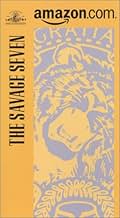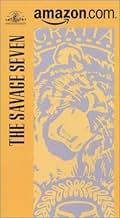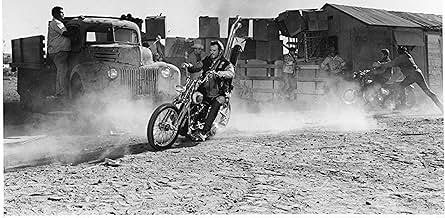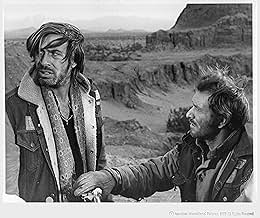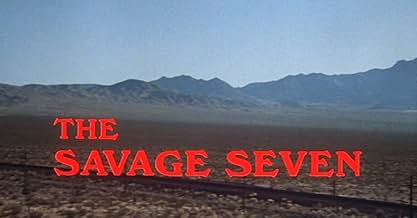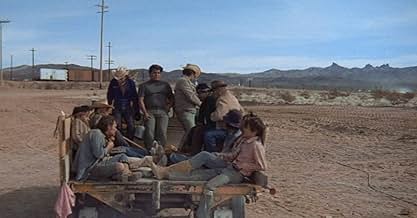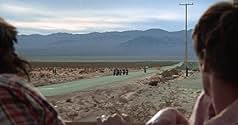Ajouter une intrigue dans votre langueMad bikers storm through an Indian reservation just to have a good ol' time.Mad bikers storm through an Indian reservation just to have a good ol' time.Mad bikers storm through an Indian reservation just to have a good ol' time.
- Réalisation
- Scénario
- Casting principal
Charles Bail
- Taggert
- (as Chuck Bail)
John 'Bud' Cardos
- Running Buck
- (as John Cardos)
Avis à la une
7emm
Biker movies have never been my can of beer. Fortunately, THE SAVAGE SEVEN is better than what I discovered so far. What it has for a basic plotline makes up for the perfect setting ever devised in the genre, an Indian resort. Pretty hilarious at times, and wait for the finale where the whole place goes up in smoke! Listen for the film's signature line: "Hey man, you just barfed on my broad!". Penny Marshall makes a very early screen appearance here. If you like classic drive-in movies, then this will be a whole lot of fun.
I actually tried to suspend belief and imagine that blue eyed Robert Walker Jr, (Johnnie) Max Julien (Grey Wolf) and Joanna Frank (Marcia) were actually Native Americans. In the early part of the movie after the bikers, led by handsome Adam Roarke (Kisum), rolled into the shanty town Joanna's character actually looked like a Native American especially in the darker bar scenes, however, once the filming moved in to the sunlight it was obvious that the beautiful lady was most likely a descendant of the Squirrel Hill Tribe. As far as the movie's plot goes the shanty town is ruled by (Mr. Fillmore) Mel Berger who works the Native Americans to the bone and takes all of their money at the company store. The film spends two much time flipping between the Bikers and Native Americans fighting each other or partying together while the evil Fillmore plots against them both. Then there is the subplot of a romance between Marcia and Kisum but there are two many points of dispute between the two and I couldn't help but think it would be better for each if they just moved on without each other.
Somehow, I did make it to the end but just didn't care anymore with all the fighting and especially the campy brain dead dialog between the bikers that really got old. I'm going to be charitable and give the the film three stars because Joanna did give her character Marcia a real calm and mellow presence making Marcia by far the most believable in a fine bit of acting among a lot of bad acting. László Kovács also did his usual great Cinematography and oh yea Penny Marshall in her first role was young and cute. I am happy that things have changed where Native American's principally play the parts of Native American's in the movies and not guys with baby blue eyes. Not that there is anything wrong with the baby blues but you know what I mean. If you want to watch a fun bikersploitation flick check out "Angels Hard as They Come" and skip The Savage Seven IMHO.
Somehow, I did make it to the end but just didn't care anymore with all the fighting and especially the campy brain dead dialog between the bikers that really got old. I'm going to be charitable and give the the film three stars because Joanna did give her character Marcia a real calm and mellow presence making Marcia by far the most believable in a fine bit of acting among a lot of bad acting. László Kovács also did his usual great Cinematography and oh yea Penny Marshall in her first role was young and cute. I am happy that things have changed where Native American's principally play the parts of Native American's in the movies and not guys with baby blue eyes. Not that there is anything wrong with the baby blues but you know what I mean. If you want to watch a fun bikersploitation flick check out "Angels Hard as They Come" and skip The Savage Seven IMHO.
OK biker flick which meanders for awhile before the inevitable "all hells breaks loose" finale. The novelty here is that most of the conflicts take place between bikers and Indians. The soundtrack contains a few songs from Iron Butterfly and Cream.
Adam Roarke and his gang ride into nowheresville, inhabited by Indians and a few white guys. Naturally the white guys, led by a large fellow played by Mel Berger, are keeping the red guys down, by having them work for low pay. Robert Walker Jr., as a blue-eyed Indian, is constantly getting beat up by everyone in the cast. Roarke sets his sights on Walker's sister, played by Joanna Frank. Of course, this leads to another beatdown of Walker. But Walker and Roarke suddenly become best buds, and take part in raiding Berger's store, supplying all the Indians with essentials like Frosted Flakes, Quaker Oats, and casino chips.
When a couple of the bikers are arrested, Berger cuts a deal with Roarke. He will decline charges against the bikers, if Roarke agrees to burn down the shacks where the Indians live. Roarke agrees, then decides to back out of the deal. He spends the night with Frank, which leads to another beatdown of Walker the next morning.
After one of the bikers is killed, Roarke thinks the Indians did it and orders his gang to destroy the village. This leads to the climax, with lots of motorcycle stunts, knifings, gunshots, people flying through the air, explosions, and one Indian having his dump in the outhouse interrupted.
Roarke is good as a creep with a slight trace of decency. Perennial biker Larry Bishop is one of the gang, and acts mentally impaired. At least, I think he was acting. Did I mention Walker gets beat up? My favorite character was the heretofore unknown Mel Berger, who is built like Tor Johnson and is always smiling, even when he is shooting someone. Laverne DeFazio makes her screen debut.
The film was produced by Dick Clark. Thankfully, none of the Indians say "How." But I suspect most of the critics said "Why?"
Adam Roarke and his gang ride into nowheresville, inhabited by Indians and a few white guys. Naturally the white guys, led by a large fellow played by Mel Berger, are keeping the red guys down, by having them work for low pay. Robert Walker Jr., as a blue-eyed Indian, is constantly getting beat up by everyone in the cast. Roarke sets his sights on Walker's sister, played by Joanna Frank. Of course, this leads to another beatdown of Walker. But Walker and Roarke suddenly become best buds, and take part in raiding Berger's store, supplying all the Indians with essentials like Frosted Flakes, Quaker Oats, and casino chips.
When a couple of the bikers are arrested, Berger cuts a deal with Roarke. He will decline charges against the bikers, if Roarke agrees to burn down the shacks where the Indians live. Roarke agrees, then decides to back out of the deal. He spends the night with Frank, which leads to another beatdown of Walker the next morning.
After one of the bikers is killed, Roarke thinks the Indians did it and orders his gang to destroy the village. This leads to the climax, with lots of motorcycle stunts, knifings, gunshots, people flying through the air, explosions, and one Indian having his dump in the outhouse interrupted.
Roarke is good as a creep with a slight trace of decency. Perennial biker Larry Bishop is one of the gang, and acts mentally impaired. At least, I think he was acting. Did I mention Walker gets beat up? My favorite character was the heretofore unknown Mel Berger, who is built like Tor Johnson and is always smiling, even when he is shooting someone. Laverne DeFazio makes her screen debut.
The film was produced by Dick Clark. Thankfully, none of the Indians say "How." But I suspect most of the critics said "Why?"
This movie is essentially about three different groups which come into conflict with each other coupled with alliances shifting back and forth. The first group consists of Native Americans who live in extreme poverty. The second group is led by a rich but extremely controlling person named "Mr. Fillmore" (Mel Berger) who exploits the Native Americans and keeps them in line by using hired thugs whenever anyone dares to complain. The third group is a motorcycle gang known simply as "MC California" who drift into the ramshackle town with the idea of fighting, drinking beer and carousing with some of the Native American females. Needless to say, Mr. Fillmore doesn't quite like all of the chaos and destruction by the motorcycle gang. On that same note, some of the Native Americans don't like the way they are treated either. But the tactics used by Mr. Fillmore are just as bad and as it turns out he now has a secret plan which will leave the Native Americans even more destitute. Now rather than reveal any more I will just say that this movie has plenty of action but very little character development. As a result several scenes lacked the necessary setup which made the movie appear to be too spontaneous and shallow. But that's just my opinion. Be that as it may, although it does have some good qualities here and there, I was generally disappointed overall and I have rated it according. Slightly below average.
About the uneasy alliance between a gang of bikers and dirt poor Native Americans with the establishment, naturally, as their common foe. Directed by Richard Rush, who would go on to make the brilliant "The Stunt Man", the film delivers on all the action and stunts you'd expect from this genre while also injecting some obvious but effective social commentary. (The powers-that-be pit the bikers and Indians against each other to dissolve their strength and perpetuate their fringe status.)
The lead biker, Adam Roarke, is commanding and charismatic - he's not the meathead you'd expect from this sort of film. In fact, there is a gravity and depth to his performance that catches you off guard at first. He's a bewildering but fascinating mix of aggression and sensitivity, someone grappling with the scrambled values of the era. I liked Robert Walker Jr. too as the hot-headed, blue-eyed Indian. Often too boyish and elf-like, he's edgier and more natural here.
The movie has style to burn and stands up as an unusually well-mounted (and richly photographed) biker flick, with some brains behind the chains. Rush doesn't seem inhibited by the common-ness of the material - he builds the characters and moves his camera (it glides and whirls like a gymnast) in typically startling fashion. The whole exercise seems to center around Roarke's memorable line "If I'm going to be a bear, it might as well be a Grizzly."
The lead biker, Adam Roarke, is commanding and charismatic - he's not the meathead you'd expect from this sort of film. In fact, there is a gravity and depth to his performance that catches you off guard at first. He's a bewildering but fascinating mix of aggression and sensitivity, someone grappling with the scrambled values of the era. I liked Robert Walker Jr. too as the hot-headed, blue-eyed Indian. Often too boyish and elf-like, he's edgier and more natural here.
The movie has style to burn and stands up as an unusually well-mounted (and richly photographed) biker flick, with some brains behind the chains. Rush doesn't seem inhibited by the common-ness of the material - he builds the characters and moves his camera (it glides and whirls like a gymnast) in typically startling fashion. The whole exercise seems to center around Roarke's memorable line "If I'm going to be a bear, it might as well be a Grizzly."
Le saviez-vous
- AnecdotesSelected by Quentin Tarantino for the First Quentin Tarantino Film Festival, which was held in Austin, Texas in 1997.
- ConnexionsFeatured in Dusk to Dawn Drive-In Trash-o-Rama Show Vol. 3 (1996)
- Bandes originalesThe Ballad of the Savage Seven
Lyrics by Guy Hemric
Music by Val Johns (as Valjean Johns)
Performed by The American Revolution (as Barbara Kelly And The Morning Good)
Meilleurs choix
Connectez-vous pour évaluer et suivre la liste de favoris afin de recevoir des recommandations personnalisées
- How long is The Savage Seven?Alimenté par Alexa
Détails
- Durée1 heure 34 minutes
- Mixage
- Rapport de forme
- 1.85 : 1
Contribuer à cette page
Suggérer une modification ou ajouter du contenu manquant

Lacune principale
By what name was Les sept sauvages (1968) officially released in Canada in English?
Répondre
